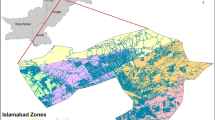Abstract
In India, the urban population is likely to be 40% of its total population by the year 2030. In such a scenario, managing urban areas is a challenge for planners in terms of developing sustainable infrastructures and addressing environmental issues. The transitional areas in the surroundings of the peripheral region of large and growing cities are called Desakota. Monitoring of such areas is essential as these provide the foundation for future urban establishments. This study tried to identify and assess the peripheral growth of Patna city, a megacity of the state of Bihar in India together with new developing urban areas by applying well-established image classification techniques on the multi-temporal Landsat satellite images of the years 1995, 2005 and 2015. Analysis of the LULC revealed a significant built-up growth in an elongated shape preferably on the upland areas. We also observed an increase in vegetation class area which is in fact due to the increased practice of agricultural plantation in low-lying areas and along the river course. Moreover, the study identified the Desakota regions for different periods, mainly along the major roads in the periphery of the city. The results were validated in the field using GPS based field survey.









Similar content being viewed by others
References
Almeida, C. M. D., Monteiro, A. M. V., Câmara, G., Soares-Filho, B. S., Cerqueira, G. C., Pennachin, C. L., et al. (2005). GIS and remote sensing as tools for the simulation of urban land-use change. International Journal of Remote Sensing, 26(4), 759–774. https://doi.org/10.1080/01431160512331316865
Bonham-Carter, G. F. (1994). Geographic information systems for geoscientists: Modeling with GIS (p. 398). Ontario: Pergamon.
Dick, H. W., & Rimmer, P. J. (1998). Beyond the third world city: The new urban geography of Southeast Asia. Urban Studies, 35(12), 2303–2320. https://doi.org/10.1080/0042098983890
Douglas, I. (2006). Peri-urban ecosystems and societies: Transitional zones and contrasting values. Peri-Urban Interface: Approaches to Sustainable Natural and Human Resource Use. https://doi.org/10.4324/9781849775878-10
Ginsburg, N. (1990). Extended metropolitan regions in Asia: A new spatial paradigm. In N. Ginsburg, B. Koppel, & T. G. Mcgee (Eds.), The urban transition: Reflections on the American and Asian experiences (pp. 21–42). Hong Kong: Chinese University of Hong Kong Press.
Kontgis, C., Schneider, A., Fox, J., Saksena, S., Spencer, J. H., & Castrence, M. (2014). Monitoring peri-urbanization in the greater Ho Chi Minh City metropolitan area. Applied Geography, 53, 377–388. https://doi.org/10.1016/j.apgeog.2014.06.029
McGee, T. G., et al. (1989). Urabanisasi or kotadesasi? Evolving patterns of urbanization in Asia. In F. J. Costa (Ed.), Urbanization in Asia: Spatial dimensions and policy issues. Honolulu: University of Hawaii Press.
McGee, T. G. (1991). The emergence of desakota regions in Asia: Expanding a hypothesis. In N. Ginsburg, B. Koppel, & T. G. McGee (Eds.), The extended metropolis: Settlement transition in Asia. Honolulu: University of Hawaii Press.
Nagasawa, R., Fukushima, A., Yayusman, L. F., & Novresiandi, D. A. (2015). Urban expansion and its influences on the suburban land use change in Jakarta metropolitan region. Urban Planning and Design Research, 3, 7–16.
Nuissl, H., Haase, D., Lanzendorf, M., & Wittmer, H. (2009). Environmental impact assessment of urban land use transitions—A context-sensitive approach. Land Use Policy, 26(2), 414–424.
Samal, D. R., & Gedam, S. S. (2015). Monitoring land use changes associated with urbanization: An object-based image analysis approach. European Journal of Remote Sensing, 48(1), 85–99. https://doi.org/10.5721/eujrs20154806
Sudhira, H. S., Ramachandra, T. V., & Jagdish, K. S. (2004). Urban sprawl: Metrics, dynamics and modeling using GIS. International Journal of Applied Earth Observation and Geoinformation, 5(2), 29–39.
Sui, D. Z., & Zeng, H. (2001). Modeling the dynamics of landscape structure in Asia’s emerging desakota regions: A case study in Shenzhen. Landscape and Urban Planning, 53(1), 37–52.
Suja, R., Letha, J., & Varghese, J. (2013). Evaluation of urban growth and expansion using remote sensing and GIS. International Journal of Engineering Research & Technology, 2(10), 2272–2779.
Wang, M. Y. L. (1997). The disappearing rural-urban boundary? Rural socioeconomic transformation in the Shenyang-Dalian region of China. Third World Planning Review, 19, 229–250.
Wu, J., Weber, B. A., & Partridge, M. D. (2016). Rural-urban Interdependence: A framework integrating regional, urban, and environmental economic insights. American Journal of Agricultural Economics., 99(2), 464–480.
Xie, Y., Batty, M., & Zhao, K. (2007). Simulating emergent urban form using agent-based modeling: Desakota in the Suzhou-Wuxian region in China. Annals of the Association of American Geographers, 97(3), 477–495. https://doi.org/10.1111/j.1467-8306.2007.00559.x
Acknowledgments
Authors are thankful to Birla Institute of Technology (BIT, Mesra, Ranchi) for constant encouragement and providing necessary facility to carry out this research. We thank USGS Earth Explorer for providing free downloadable Landsat series of satellite data. We also acknowledge the critical review comments provided by anonymous reviewer.
Author information
Authors and Affiliations
Corresponding author
Additional information
Publisher's Note
Springer Nature remains neutral with regard to jurisdictional claims in published maps and institutional affiliations.
Electronic supplementary material
Below is the link to the electronic supplementary material.
Supplementary file1
Block map of Patna district (PNG 598 kb)
Supplementary file2
Block wise population density map of Patna district, 1991 (PNG 1826 kb)
Supplementary file3
Block wise population density map of Patna district, 2001 (PNG 1835 kb)
Supplementary file4
Block wise population density map of Patna district, 2011 (PNG 1717 kb)
About this article
Cite this article
Khan, B., Rathore, V.S. & Krishna, A.P. Identification of Desakota Region and Urban Growth Analysis in Patna City, India Using Remote Sensing Data and GIS. J Indian Soc Remote Sens 49, 935–945 (2021). https://doi.org/10.1007/s12524-020-01248-8
Received:
Accepted:
Published:
Issue Date:
DOI: https://doi.org/10.1007/s12524-020-01248-8




